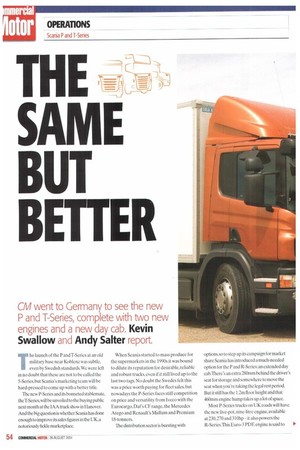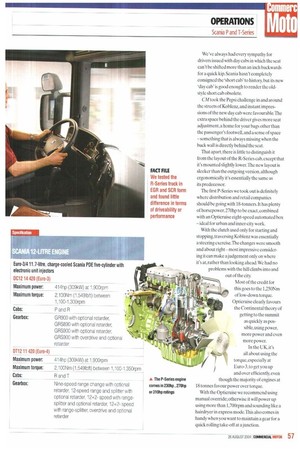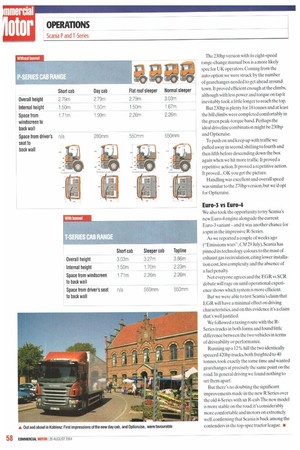THE SAME BUT BETTER
Page 54

Page 56

Page 57

Page 58

If you've noticed an error in this article please click here to report it so we can fix it.
CM went to Germany to see the new P and T-Series, complete with two new engines and a new day cab. Kevin
Swallow and Andy Salter report.
11 he launch of the P andT-Series at an old military base near Koblenz was subtle, even by Swedish standards We were left in no doubt that these are not to be called the 5-Series, but Scania's marketing team will be hard-pressed to come up with a better title.
The new P-Series and its bonneted stablemate, theT-Series,will be unveiled to the buying public next month at the IAA truck show in Hanover. And the big question is whether Scania has done enough to improve its sales figures in the UK,a notoriously fickle marketplace. When Scania started to mass produce for the supermarkets in the 1990s it was bound to dilute its reputation for desirable, reliable and robust trucks, even if it still lived up to the last two tags. No doubt the Swedes felt this was a price worth paying for fleet sales, but nowadays the P-Series faces stiff competition on price and versatility from lveco with the Eurocargo. Daf s CF range, the Mercedes Atego and Renault's Midlum and Premium 18-tonners.
The distribution sector is bursting with options, so to step up its campaign for market share Scania has introduced a much-needed option for the P and R-Series: an extended day cab.There's an extra 280mm behind the driver's seat for storage and somewhere to move the seat when you're taking the legal rest period. But it still has the 1.2m floor height and that 460mm engine hump takes up a lot of space.
Most P-Series trucks on UK roads will have the new five-pot, nine-litre engine, available at 230.270 and 310hp —it also powers the R-Series. This Euro-3 PDE engine is said to be exceptionally fuel efficient, helped by bags of low-down torque.That's no surprise as it's based on the six-cylinder 11 and 12-litre engines, which are designed for the longdistance and construction markets — Scania claims it will happily lug down to 1,000rpm to pull you out of the mud.
The 230 and 270hp options develop peak torque at 1,100-1,300rpm; the 310hp variant loses that spread with a peak at 1300rpm. But there's 1,550Nm to call on, which is more than some tractors pulling more weight.
Scania has also developed a 12-litre, 420hp Euro-4 engine 12 months ahead of the deadline; it will be available next month and is identical to its 420hp Euro-3 predecessor except for a 30-80% cut in emission levels. Meeting Euro-4 almost a full year early will give Scania a chance to see how it will do in the field. Fuel consumption is the issue, but there's little to suggest it won't match the Euro-3 figure.
Euro-4 has been achieved with Scania's own exhaust gas recirculation (EGR) system. which means some of the exhaust gases are cooled by the engine before being fed to the intake manifold.The technology developed for this engine will underpin the move to Euro4 for the rest of Scania's diesel engines.
The T-Seriesisn't a big seller in the UK, although operators pulling shorter 30ft trailers seem to be selecting the bonneted cab in increasing numbers.
There are four cab options for the P-Series. five for the R-Series and three for the T-Series. But this launch was all about the day cab and the two engines. The cab's design, both outside and in, is little more than an extension of the 4-Series line up. But like the man said, if it ain't broke,don't fix it.
Driving impressions
For driving impressions on the new P-Series we took out two day-cab 18-tonne rigids with two ratings from the nine-litre engine. We were impressed by the sound and powerful five-cylinder lump, and by the extra room in the cab. We've always had every sympathy for drivers issued with day cabs in which the seat can't be shifted more than an inch backwards for a quick kip. Scania hasn't completely consigned the 'short cab' to history, but its new 'day cab' is good enough to render the oldstyle short cab obsolete.
CM took the Pepsi challenge in and around the streets of Koblenz, and instant impressions of the new day cab were favourable.The extra space behind the driver gives more seat adjustment, a home for your bags other than the passenger's footwell, and a sense of space — something that is always missing when the back wall is directly behind the seat.
That apart, there is little to distinguish it from the layout of the R-Series cab, except that it's mounted slightly lower. The new layout is sleeker than the outgoing version, although ergonomically it's essentially the same as its predecessor.
The first P-Series we took out is definitely where distribution and retail companies should be going with 18-tonners. It has plenty of horsepower,270hp to be exact, combined with an Opticruise eight-speed automated box — ideal for urban and inner-city work.
With the clutch used only for starting and stopping, traversing Koblenz was essentially a steering exercise.The changes were smooth and about right—most impressive considering it can make a judgement only on where it's at, rather than looking ahead. We had no problems with the hill climbs into and out of the city.
Most of the credit for • this goes to the 1250Nm of low-down torque. Opticruise clearly favours the Continental theory of getting to the summit as quickly as possible, using power, more power and even more power.
In the UK, it's all about using the torque.especially at Euro-3, to get you up and over efficiently, even though the majority of engines at 18 tonnes favour power over torque.
With the Opticruise we recommend using manual override; otherwise it will power up using more than 1,700rpm and sounding like a hairdryer in express mode.This also comes in handy when you want to maintain a gear for a quick rolling take-off at a junction. The 230hp version with its eight-speed range-change manual box is a more likely spec for UK operators. Coming from the auto option we were struck by the number of gearchanges needed to get ahead around town. It proved efficient enough at the climbs, although with less power and torque on tap it inevitably took a little longer to reach the top.
But 230hp is plenty for 18 tonnes and at least the hill climbs were completed comfortably in the green peak-torque band. Perhaps the ideal driveline combination might be 230hp and Opticruise.
To push on and keep up with traffic we pulled away in second.shifting to fourth and then fifth before descending down the box again when we hit more traffic. It proved a repetitive action. It proved a repetitive action. It proved... OK you get the picture.
Handling was excellent and overall speed was similar to the 270hp version, but we'd opt for Opticruise.
Euro-3 vs Euro-4
We also took the opportunity to try Scania's new Euro-4 engine alongside the current Euro-3 variant and it was another chance for a spin in the impressive R-Series.
As we reported a couple of weeks ago ("Emissions wars-, CM 29 July), Scania has pinned its technology colours to the mast of exhaust gas recirculation,citing lower installation cost,less complexity and the absence of a fuel penalty.
Not everyone agrees and the EGR vs SCR debate will rage on until operational experience shows which system is more efficient.
But we were able to test Scania's claim that EGR will have a minimal effect on driving characteristics, and on this evidence it's a claim that's well justified.
We followed a taxing route with the RSeries trucks in both forms and found little difference between the two vehicles in terms of driveability or performance.
Running up a 12% hill the two identically specced 420hp trucks, both freighted to 40 tonnes, took exactly the same time and wanted gearchanges at precisely the same point on the road. In general driving we found nothing to set them apart.
But there's no doubting the significant improvements made in the new R Series over the old 4-Series with an R-cab.The new model is more stable on the road: it's considerably more comfortable and motors on extremely well, confirming that Scania is back among the contenders in the top-spec tractor league. •


























































































































































































